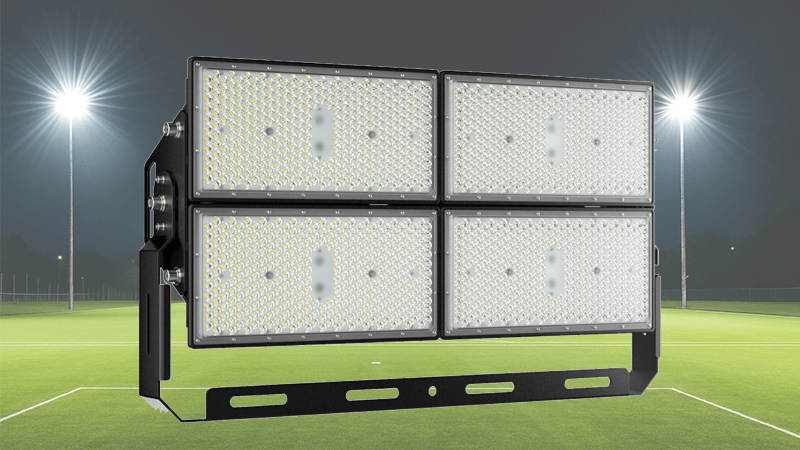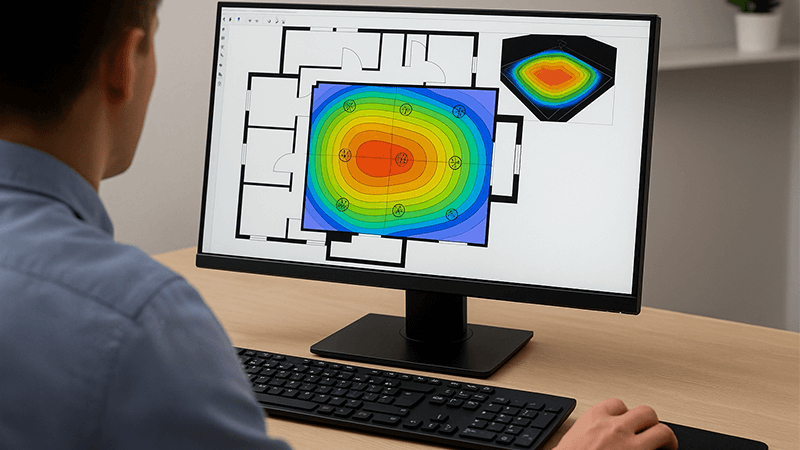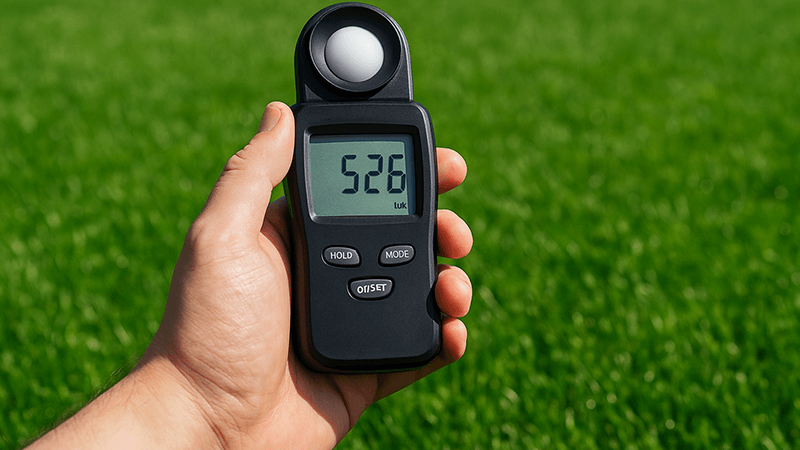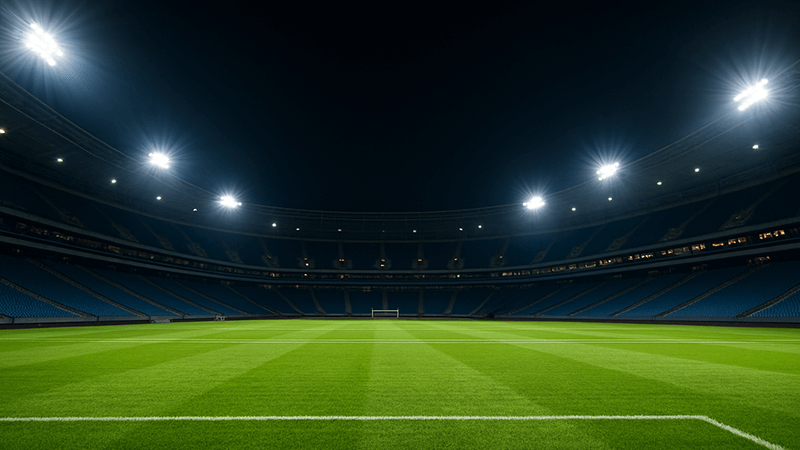Last Updated on: September 18, 2025Choosing the wrong floodlights is a costly mistake. Poor visibility angers players and fans, while high energy bills and constant maintenance drain your budget. You need a reliable solution.
To choose the right LED floodlight for a sports field, you must match the fixture’s specifications to the sport and venue size. Key factors include lumen output (brightness), beam angle (coverage), color rendering index (CRI), and durability ratings like IP and IK for weather resistance.

Getting sports lighting right is a high-stakes game. A bad choice doesn’t just lead to a poorly lit field; it can lead to project failure, safety hazards, and massive unforeseen costs. I have been in the LED lighting industry for many years, from working on the factory floor to building my own manufacturing business. I’ve learned that success comes from understanding the details. Let’s break down exactly what you need to know to make the right choice every time and ensure your project is a success from day one.
How do I choose the right floodlight?
Overwhelmed by technical specs? It’s easy to get lost in datasheets and make a costly mistake. And the wrong choice leads to poor lighting and wasted money.
To choose the right floodlight, first define its purpose. Then, calculate the needed brightness based on area size. Finally, check the beam angle for coverage, CRI for color accuracy, and IP/IK ratings for long-term durability against weather and impacts.

Choosing a floodlight feels complex, but it becomes simple when you break it down into a few key decisions. It is not just about picking the brightest light; it is about finding the right light for a specific job. For a purchasing manager like Shaz, having a clear framework is essential for negotiating with suppliers and ensuring you acquire a product that delivers real value. I always advise my clients to focus on the application first, then match the specs to the need. A little planning here saves a lot of headaches later. This systematic approach ensures you don’t overpay for features you don’t need or, worse, under-spec a light that fails to perform.
Key Factors Breakdown
The technical datasheet tells a story. You just need to know how to read it. I have learned that a few key numbers determine over 90% of a floodlight’s performance in the field. Understanding them is your best tool.
| Factor |
Why It Matters |
My Recommendation |
| Lumens/Wattage |
Lumens measure total brightness, while wattage measures energy use. You need enough lumens to light the area safely and effectively. |
Don’t just shop by wattage. Always compare lumen output (lm) and efficacy (lm/W). Higher efficacy means more light for less energy, which leads to significant cost savings over the product’s lifetime. |
| Beam Angle |
This determines how wide or narrow the light spread is. A narrow beam throws light a long distance, while a wide beam covers a large area up close. |
For sports fields with tall poles, you need narrow beam angles (e.g., 15-30 degrees) to push light to the center of the field. For general area lighting, wider angles (60-120 degrees) work best. |
| CRI/CCT |
Color Rendering Index (CRI) measures how accurately colors appear under the light. Color Correlated Temperature (CCT) is the color of the light itself (e.g., warm or cool white). |
For sports, especially if televised, a CRI of 80+ is essential for accurate jersey colors. A CCT of 5000K-5700K (cool white) is standard as it mimics natural daylight and enhances alertness. |
| IP/IK Rating |
IP ratings measure protection against dust and water. IK ratings measure resistance to impact. These are critical for outdoor durability. |
Never go below IP65 for outdoor fixtures. For sports fields, I strongly recommend IP66 or higher. An IK08 rating is a good baseline to protect against impacts from balls or debris. |
The Critical Importance of Durability
One of the biggest lessons I’ve learned is that sports field lights live a very hard life. They are exposed to wind, rain, extreme heat, and freezing cold for years. They also endure constant vibration. If the light’s protection is not good enough, water and dust will get inside. This leads to short circuits, component failure, and the light getting dimmer much faster than it should.
The cost to fix this is huge. Replacing a floodlight on a tall stadium pole isn’t a simple job. It requires specialized high-access vehicles, like a crane or a large boom lift. Renting this equipment and hiring a qualified crew is extremely expensive and causes major downtime for the field. The cost of one maintenance call can be many times the original cost of the light itself. This is why investing in a highly durable fixture with an IP66 rating or better from the start is not an expense—it is your best insurance against future costs.
What are the lighting standards for athletic fields?
Are you unsure about lighting regulations? Non-compliance can get your project rejected and create serious safety hazards for players. This can even lead to legal issues.
Athletic field lighting standards are defined by groups like the IES and CIBSE, and sports bodies like FIFA. These rules dictate minimum light levels (lux), uniformity, glare, and color rendering to ensure safety, fairness, and broadcast quality for different competition levels.

Following established standards is not optional; it is the foundation of a successful project. These guidelines are created by engineers and sports experts to ensure two things above all else: player safety and fair competition. Whether it’s a local practice field or an international stadium, the light must be good enough for players to see the ball, each other, and the field boundaries clearly. These standards also create a common language for everyone involved in a project, from the client to the installer. When you specify that a field must meet "IES Class II" standards, everyone knows exactly what level of performance is required. This clarity prevents misunderstandings and ensures the final result meets expectations.
Understanding Key Lighting Metrics
To meet any standard, you first have to understand the language it uses. Lux, uniformity, and CRI are not just technical terms; they are the measurements that define the quality of light on the field.
- Lux (lx): This is the measure of luminous flux per unit area, or simply, the amount of light hitting a surface. It is the most basic measure of brightness. A higher lux level means a brighter field.
- Uniformity (U): This is perhaps more important than raw brightness. Uniformity measures how evenly the light is spread across the entire playing surface. It is expressed as a ratio, most often Umin/Uavg (the brightness of the dimmest spot divided by the average brightness). Poor uniformity creates dark spots and bright spots, which can be dangerous for players and frustrating for spectators.
- Color Rendering Index (CRI): This measures the ability of a light source to reveal the colors of objects faithfully in comparison with a natural light source. On a scale of 0-100, a higher CRI means better color accuracy. This is vital for distinguishing team uniforms and is a non-negotiable for television broadcasting.
- Glare (UGR): Glare is the visual discomfort caused by excessive brightness. For sports lighting, controlling glare is critical. A player looking up to catch a ball should not be blinded by the lights. Standards set maximum glare ratings to ensure player comfort and safety.
Major Governing Bodies and Their Focus
Different organizations publish lighting guidelines, and the one you follow depends on the project’s location and the sport being played. As a purchasing manager, you need to ask the project owner which level of play the venue will host. This is the most important question, as it dictates all other lighting requirements.
| Level |
Description |
Typical Lighting Goal |
| Class I |
International/Professional with TV broadcast |
Very high lux levels, excellent uniformity (e.g., >0.7), high CRI (>80-90), and very strict glare control for broadcast quality. |
| Class II |
Regional/Club Competition |
Medium lux levels, good uniformity (e.g., >0.6), and good CRI (>70). Sufficient for competitive play and spectator viewing. |
| Class III |
Training/Recreational Play |
Basic lux levels for safety and general play, with less strict uniformity requirements (e.g., >0.5). |
Knowing the intended Class of play before you source any products will save you time and help you get accurate quotes. For example, lighting for a Class I stadium is a completely different world from a Class III practice field, both in product specification and in cost.
What are the lux levels for sports field lighting?
Confused about how much light you truly need? Guessing the right lux level is a recipe for failure. Too little light is unsafe, while too much wastes energy and money.
Lux levels for sports fields vary widely. A small recreational field might only need 100-200 lux for safety. In contrast, a professional stadium hosting televised events often requires 1000-2000 lux or more for clear, high-definition broadcasts.

Specifying the correct lux level is a balancing act. You need enough light for safe and enjoyable play, but every extra lux costs money in both upfront equipment and long-term energy consumption. This is why lighting standards are so valuable. They provide a proven target based on decades of experience. For any project, my first step is always to identify the sport and the level of competition. This immediately narrows down the required lux levels from a wide guess to a specific, defensible range. It transforms the conversation from "how bright should it be?" to "we need to achieve 500 lux for Class II competition."
Lux Level Recommendations by Sport
Different sports have different needs. A fast-moving small ball, like in tennis, requires more light to track than a larger ball used in football. The following table provides a general guide based on common standards. Always consult the specific governing body’s latest documents for official requirements.
| Sport |
Recreational/Training (Class III) |
Club/Regional (Class II) |
Professional/Broadcast (Class I) |
| Football (Soccer) |
150-250 lux |
300-500 lux |
1000-2000+ lux |
| Tennis |
200-300 lux |
400-600 lux |
800-1200+ lux |
| Basketball (Outdoor) |
150-250 lux |
300-500 lux |
500-750+ lux |
| Multi-Purpose Field |
100-200 lux |
200-400 lux |
500+ lux |
Beyond Lux: The Role of Uniformity
Having a high average lux level is meaningless if the field has dark patches and blinding hotspots. This is where uniformity comes in. I often tell my clients to think of it this way: high lux without good uniformity is like trying to read a book in a room with a single, harsh spotlight. You have a lot of light in one spot, but you can’t see anything else. A well-lit field needs smooth, even coverage.
Uniformity is measured as a ratio, typically from 0 to 1. A uniformity ratio of 0.7 means the darkest spot on the field is at least 70% as bright as the field’s average brightness. For professional play (Class I), a uniformity of 0.7 or 0.8 is often required. For recreational fields (Class III), a ratio of 0.5 might be acceptable. Achieving high uniformity is a function of both the floodlight’s beam angle and the lighting design—the height, placement, and aiming of every single fixture. This is why working with a supplier who can provide a professional lighting simulation using software like DIALux is critical. This simulation proves that the proposed design will meet the required lux and uniformity levels before you spend a single dollar on hardware.
Lighting a huge football field is complex. Making the wrong choice can ruin the experience for everyone. Poor lighting causes player errors and looks terrible on TV.
The best lighting for a football field uses high-power LED floodlights with precise, narrow beam angles to achieve high uniformity and minimal glare. Key features include a high CRI (80+), flicker-free technology for TV replays, and a robust IP66+ build.

Lighting a football field properly is one of the most demanding applications in sports lighting. The large area and the need for excellent visibility from every angle make it a significant engineering challenge. The goal is to create a visual environment that feels like daylight for players, spectators, and television cameras. It’s not just about flooding the field with light. The best systems deliver light exactly where it is needed and nowhere else, maximizing efficiency and minimizing light pollution and glare. From my experience helping clients with stadium projects, success depends entirely on combining high-quality fixtures with an expert lighting design.
To achieve professional results, you must look for a specific set of features that work together as a system. Here are the non-negotiables:
- High-Power LED Floodlights: LED is the undisputed standard for its energy efficiency, long lifespan, and instant-on capability. For a full-sized football field, fixtures will typically range from 500W to 1500W.
- Precise Optics/Beam Angles: This is the most critical element for football fields. Because the poles are tall and set far back from the pitch, you need fixtures with narrow beam angles (e.g., 15-25 degrees) to project light efficiently over long distances. Combining different beam angles in the design is key to achieving high uniformity.
- High CRI: For any competition that might be filmed or televised, a CRI of 80 or higher is mandatory. For top-tier professional leagues, the requirement is often CRI 90+. This ensures team colors and sponsor logos look true and vibrant on screen.
- Flicker-Free Technology: Standard LEDs can show a flicker on slow-motion or super-slow-motion replays. Broadcast-ready floodlights use special drivers that eliminate this effect, which is absolutely essential for modern sports broadcasting.
- Superior Durability and Thermal Management: A 1500W LED fixture generates a lot of heat. It needs a well-designed heat sink to dissipate that heat effectively and protect the LED chips. Combined with an IP66+ rating and robust construction, this ensures the light performs reliably for its entire lifespan, because servicing a light on a 40-meter stadium mast is a major operation.
Typical Pole Layout and Configuration
The physical layout of the lighting poles is fundamental to the design. The two most common configurations are:
- 4-Pole System: This involves placing four very tall masts at the corners of the stadium. This layout requires floodlights with very narrow beam angles to throw light all the way to the center of the field. It minimizes obstructions along the sidelines but can create challenges with shadowing if not designed perfectly.
- 6 or 8-Pole System: This popular configuration uses more poles (three or four along each sideline) that are typically shorter than those in a 4-pole system. This allows for the use of slightly wider beam angles and can make it easier to control glare and shadows.
The best layout depends on the stadium’s architecture, budget, and specific lighting goals. In almost every project I’ve been a part of, the final step before ordering products is to run a comprehensive DIALux simulationwww.paclights.com/learning-center/sports-lighting-levels-what-you-need-to-know/) simulation. It’s the single best way to validate the design, confirm it meets all standards, and ensure the client gets the performance they are paying for.
Conclusion
Choosing the right sports floodlight requires a focus on performance, compliance with standards, and long-term durability. By prioritizing these key details, you will deliver a successful, reliable, and cost-effective project.